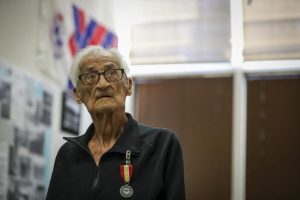Eight decades after 10th Mountain Division soldiers trained at Colorado’s historic Camp Hale for combat in World War II, Army Staff Sgt. Cam Daniels stood on a snow-covered mountainside west of Vail Pass and reflected on the legend they created in the rugged but picturesque landscape between Leadville and Vail.
One of them was his great-grandfather, Wayne Peters, who was killed while fighting German forces in northern Italy in the final weeks of the war.
“Very emotional,” Daniels said, five hours into a 15-hour backcountry ski tour he and nine other soldiers from the 10th Mountain Division — now based at Fort Drum in western New York — undertook last week to honor their World War II predecessors.
They would ski from Camp Hale to Vail to commemorate the arduous D Series exercises that unfolded there over three weeks in 1944. D Series was, in effect, the 10th’s final exam before they fought in Italy’s Apennine Mountains. Peters was one of 975 10th Mountain soldiers killed in Italy.
“This has just been an absolute honor to be here,” Daniels said at the foot of Shrine Mountain, taking a break during the 24-mile “Hale to Vail” journey. “Just to be able to continue not only the 10th Mountain Division’s legacy — why we’re all here — but a really special moment for me to continue my great-grandfather’s legacy; kind of follow in his footsteps. Maybe hook onto the same pitons that he did here at Camp Hale, ski in the same tracks. Super special to be here.”
After the war, 10th Mountain Division vets helped found dozens of U.S. ski resorts including Aspen, Vail, and Arapahoe Basin. Today the area where the 10th prepared for war from 1942-44 is prime recreational backcountry terrain as part of the Vail Pass Winter Recreation Area, annually attracting an estimated 58,000 skiers, snowshoers, and snowmobilers according to the U.S. Forest Service. Parts of the area were designated the Camp Hale-Continental Divide National Monument in 2022.
For 10th Mountain today, it remains sacred ground. During the D Series, the ski troops held war games lugging heavy packs, rifles, and gas masks up steep 12,000-foot mountains and schussing down ravines, night and day, on seven-foot-long wooden skis. They slept in snow holes, enduring blizzards and sub-zero temperatures.
In combat, the 10th is probably best known for a February 1945 battle with Nazi forces occupying strategic Riva Ridge in Italy, a surprise attack described in a 32-page timeline compiled by the National Association of the 10th Mountain Division:
“On the evening of the 18th, 700 men … make a daring night climb and successful assault on Riva Ridge, which rises steeply 1,700-2,000 feet above the rushing Dardagna River. The attack utilizes five carefully prepared climbing routes, including two that require fixed ropes. Surprise is complete, and by daybreak the mountaineers have taken Riva Ridge at the cost of only one casualty. But ferocious counterattacks immediately put the achievement in jeopardy. Not until Feb. 25 is the entire Riva Ridge in our hands.”
In the battle to hold Riva Ridge, 21 10th Mountain troops were killed. After Riva, the 10th fought its way 100 miles north to Lake Garda, where the Germans surrendered on May 2, five days before the end of the war in Europe.
The Camp Hale D Series was designed to push troops to the limits of their endurance, and it did. A plaque quoting ski trooper Bruce Campbell currently hanging in the Winter Warriors marquee exhibition at the History Colorado Center, which honors the 10th, makes that clear:
“Except for being shot at, the conditions were much worse during the D Series than anything we would face in combat,” Campbell said.
Daniels’ great-grandfather was killed in the Po River Valley when his grandmother was 2 years old.
“What these guys were doing here at Camp Hale was no easy feat,” Daniels said. “It took a lot of training, a lot of expertise and a lot of good instructors. It’s eye-opening when you see (the landscape) first-hand. Those guys were the real deal.”
PFC Rylan Parsons, who is from Jackson, Wyo., came to appreciate the exploits of the World War II 10th when she took her mother to a 10th Mountain Division museum at Fort Drum.
“It’s super special to me,” said Parsons, a geospatial engineer whose job includes map-making. “It’s super motivating. I don’t think many people get the chance to follow such historic people and do such historic things. It’s been really inspiring, and honestly I’m very grateful for the experience to take my skiing skills and be able to emulate what my ancestors did.”
Early in the Hale to Vail traverse, the soldiers climbed 2,600 feet to Ptarmigan Pass, which is connected to a towering 12,000-foot ridge known to today’s backcountry mountaineers as Machine Gun Ridge. They call it that because spent shell casings and other Army paraphernalia from the 1940s still turn up occasionally.
10th Mountain veteran Harris Dusenbery described climbing that ridge one night in 1944 in his book “Ski the High Trail,” a personal account of the D-Series maneuvers.
“Traverse and kick-turn, traverse and kick-turn, repeat and repeat it,” Dusenbery wrote, “herringbone up this slope, traverse again, side-step up this icy spot, rest — oh, so rarely did we rest — sweat and struggle on, gulp hard at the thin life-giving air, strain to keep up, utter a hundred vain curses for the 50 pounds of rucksack on your back, for the ache in your shoulders, the sweat in your eyes, the skis on your feet, but ‘keep moving’ is the order of the day.”
Despite the hardships, his description of the view that night on top of the ridge came straight from a mountaineer’s heart.
“I stood facing toward snowy peaks and the pyramid that we called Ptarmigan Mountain,” the Montana native wrote. “Behind me abruptly rose the shoulders and peak of Sugarloaf (Peak). Around me the distant horizon was circled with jagged summits and snow-covered ridges, range after range of glorious mountains, all sparkling in the moonlight. … The wind whistled softly about my parka hood and blew whirling wisps of snow along the surface. I knew that this was a perfect spring night at 12,000 feet of elevation in the Colorado Rockies.”
Ptarmigan Pass, with its view of Machine Gun Ridge, was the toughest climb of the day for the Hale to Vail soldiers. They climbed on alpine touring gear designed for ski mountaineering.
“I’m not going to say it’s the easiest thing to do, but it’s been very doable,” said Parsons, the only female soldier on the mission. “But, I say that as I’m skiing on 2023 ultra-light skis, whereas the original 10th Mountain people did this on wooden planks. They’re the real athletes.”
The Hale to Vail traverse was followed by the 49th annual reunion of 10th Mountain Division veterans and descendants with festivities at Copper Mountain, Ski Cooper and Vail. The Vail event included lectures, a Black Hawk helicopter landing, a parade, a ceremonial ski down the Riva Ridge trail and a ski troopers race.
While visiting the “Winter Warriors” exhibition in downtown Denver last week with a few of his troops, Lt. Col. Marc Cleveland described the objective of the Hale to Vail trek — to “Link the Legacy” between the original 10th Mountain troops and those who serve today. The 10th is currently deployed in Iraq and Syria, and was deployed in Afghanistan during the U.S. presence there.
“Being at Camp Hale, skiing and snowshoeing and climbing and doing avalanche training in the same location where the people who came before us did the same things, it’s a reminder that while a lot of things change, some things stay the same,” Cleveland said.
“We’re always going to have a need for people who are experts at operating in a mountainous environment in the cold and the wind and the rain and the snow,” he added. “They’ve got to be tough and resilient and confident and competent. The outdoorsmen, the skiers, the climbers, the muleskinners that came together (during World War II) to put together this division — to go and do a job that was necessary — our soldiers have the all of those same characteristics.”
The Hale to Vail route took the soldiers from where Camp Hale was located, at the foot of Tennessee Pass, northeast to Ptarmigan Pass, then on a northward traverse along Shrine Mountain — a familiar landmark visible today from Interstate 70 at Vail Pass — to Shrine Pass (11,178 feet). From there they skied northwest to the eastern limits of the Vail ski area above the back bowls, then down into Vail Village.
Accompanied by members of the National Ski Patrol — which was deeply involved in the formation of the 10th Mountain Division and subsequent recruitment efforts — the Hale to Vail skiers arrived at the bottom of Gondola 1 in Vail shortly after 7 p.m.
Parsons, the mapmaker, had the trip data on her GPS watch: 24.4 miles with 5,602 feet of climbing, elapsed time 15 hours, 16 minutes, 47 seconds.
“I enjoyed the beauty the entire time,” Parsons said. “It was definitely a challenge, and it pushed all of us mentally at times, but it was so exciting to be part of the first group to bring back that traverse and bring back alpine to 10th Mountain.
“I think the coolest moment was getting on Ptarmigan Pass together as a group, because that was really our biggest hurdle,” she said. “Getting to the top, seeing the mountains, seeing the sunrise, was probably my favorite moment in the entire thing.”
©2024 MediaNews Group, Inc. Visit at denverpost.com. Distributed by Tribune Content Agency, LLC.
Story Continues
© Copyright 2024 The Denver Post. All rights reserved. This material may not be published, broadcast, rewritten or redistributed.
Please rate this CIBA article
Vote






